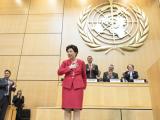May 28, 2010
Global, US H1N1 transmission very low
The World Health Organization (WHO) again reported only low global pandemic flu activity, with the most active areas in the Caribbean and Southeast Asia, which are experiencing "low-level circulation," notably in Cuba, Singapore, Malaysia, and Bangladesh. Except for localized areas in Chile, the temperate Southern Hemisphere is showing little evidence of H1N1 activity. Seasonal influenza strains continue to be detected at low levels globally. The CDC also reported very low US rates today.
http://www.who.int/csr/don/2010_05_28/en/index.html
May 28 WHO update
Adjuvanted split-virion vaccine performs well in kids
In a study of the two vaccines used in Britain during the pandemic, the split-virion version with an immune-boosting adjuvant produced a stronger immune response in children than did the whole-virion vaccine. The study, of 937 UK children 6 months to 12 years old, compared an adjuvanted, egg-based split-virion H1N1 vaccine with an unadjuvanted, cell-based whole-virion version. While the split-virion vaccine induced a stronger immune response, it also produced more adverse reactions.
http://dx.doi.org/10.1136/bmj.c2649
May 27 BMJ abstract
Taiwan school vaccine campaign led to mass hysteria
Public officials in Taiwan yesterday described 23 clusters of mass psychogenic illness after pandemic flu vaccination in school children, who started receiving the vaccine at schools last November. After the first cluster, officials looked for others. Ten involved 15 or more children, median age was 13, and 68% were girls. Researchers said intense media coverage and suspicion about the vaccine contributed to the events, which show a need for surveillance and communication strategies.
http://tinyurl.com/eurosurv052710hysteria
May 27 Eurosurveillance study
Study finds H1N1, seasonal flu differ subtly
Researchers who compared patterns between patients with seasonal and pandemic flu at two Philadelphia hospitals found few clinical differences between the two groups, though pandemic flu patients tended to have more lower respiratory symptoms. They found that pregnancy was the only risk condition that was more common in the pandemic group, and those with pandemic flu were younger, with a median age of 29, compared with 59.
http://dx.doi.org/10.1086/653204
May 25 Infect Control Hosp Epidemiol study


















